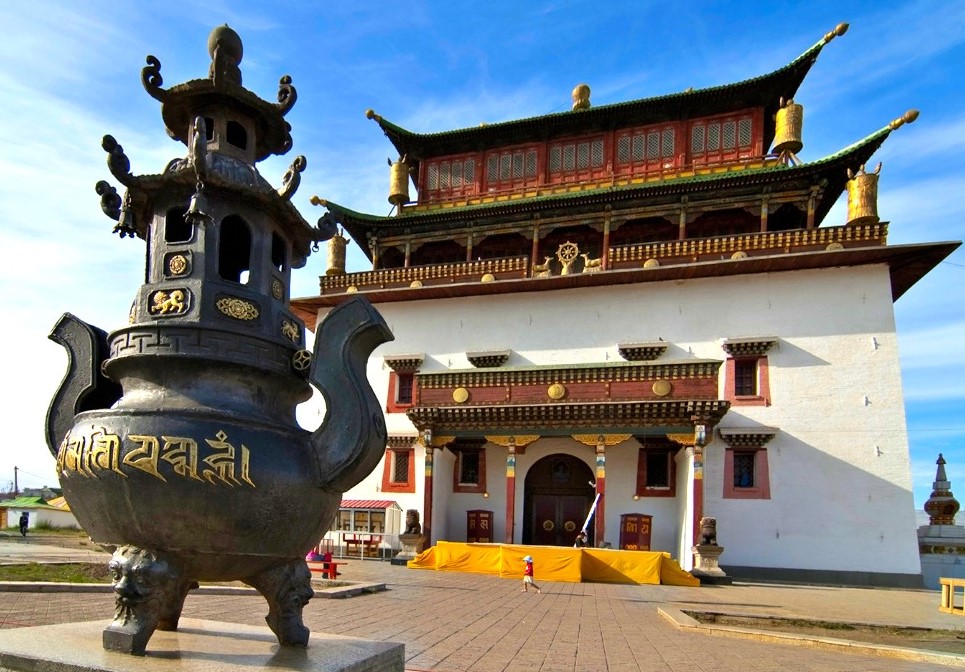Religion
Mongolian Religion Explained: History, Traditions, and Modern Faiths
Religion in Mongolia reflects a rich tapestry of ancient traditions, spiritual philosophies, and cultural resilience. The country’s beliefs have evolved through centuries of nomadic life, empire-building, and foreign influence — yet spirituality continues to play a central role in shaping Mongolian identity.
Today, roughly 53% of Mongolians identify as Buddhist, 3–4% as Muslim (mainly Kazakhs in Bayan-Ölgii), 2% as Christian, and about 40% report no formal religion.
Mongolian Religious Beliefs Troughout History
Even before Tengrism took shape, early Mongolic tribes practiced animistic beliefs, worshipping natural elements such as the sun, moon, and mountains as sacred spirits guiding human fate.
Pre-13th Century – Ancient Shamanism and Tengrism
Before the rise of the Mongol Empire, early Mongolian tribes practiced Tengrism, also known as Mongolian Shamanism. People worshipped Tengri, the eternal blue sky, and honored spirits of nature and ancestors. Shamans (böö) acted as mediators between humans and the spiritual world, performing rituals for health, fortune, and harmony with nature.
13th–14th Centuries – Religious Tolerance under the Mongol Empire
During the Mongol Empire (1206–1368), religious tolerance became official policy. Genghis Khan and his successors allowed Buddhists, Muslims, Christians, and Shamans to practice freely. Mongol rulers saw religion as a unifying tool rather than a source of conflict. Nestorian Christianity, Islam, and Tibetan Buddhism all flourished within the empire’s vast lands.
16th–17th Centuries – Rise of Tibetan Buddhism
In the late 1500s, Mongolian ruler Altan Khan invited Tibetan lamas to spread Buddhism. He granted the title “Dalai Lama” to the Tibetan spiritual leader, marking the start of strong religious ties between Mongolia and Tibet. Buddhism gradually replaced shamanism as the dominant faith, though shamanic traditions continued in rural areas. Monasteries became key centers of learning and culture.
17th–19th Centuries – Buddhism’s Golden Age
During this period, Tibetan Buddhism (specifically the Gelugpa school) became deeply rooted in Mongolian society. Thousands of monasteries and temples were built, and nearly one-third of Mongolian men became monks. Religious art, scripture, and festivals thrived, making Buddhism the heart of Mongolian identity and daily life.
Under Qing rule (1691–1911), Buddhism remained dominant but was closely regulated by the Manchu state. The Qing emperors supported monasteries yet used religion to consolidate control over Mongolian society
1920s–1990 – Communist Suppression and Atheism
After Mongolia declared independence from the Qing in 1911, the Bogd Khan — the country’s highest Buddhist leader — became both spiritual and political head of state, marking a brief theocratic era before communist rule.
Then Mongolia became a Soviet-aligned communist state, religion was harshly suppressed. Monasteries were destroyed, monks were executed or imprisoned, and public worship was banned. Atheism became state ideology, and generations grew up without religious education. By the 1980s, only a few secret practitioners of Buddhism and shamanism remained.
1990–Present – Religious Freedom and Revival
Following the democratic revolution in 1990, Mongolia’s new constitution guaranteed freedom of religion. Buddhism re-emerged as the majority faith, while shamanism, Islam, and Christianity also revived. Today, most Mongolians identify as Buddhist, while others are shamanist, Muslim, Christian, or atheist. Religion in modern Mongolia reflects both ancient traditions and new global influences — a blend of spirituality, cultural heritage, and open-minded coexistence.
Mongolian Tengriism & Shamanism
Before Buddhism arrived, Tengrism (also known as Mongolian Shamanism) was the dominant belief system. It centers around worship of Tengri, the eternal blue sky, and reverence for nature, ancestors, and spirits.
Shamans (böö) act as intermediaries between humans and the spirit world, performing rituals to heal illnesses, predict the future, and maintain balance between people and the natural world.
Even today, many Mongolians, especially in rural areas, continue to practice shamanistic rituals alongside Buddhist beliefs.
Mongolian Buddhism
Tibetan Buddhism became the main religion of Mongolia in the 16th century when Altan Khan invited Tibetan lamas to spread Buddhist teachings. The Dalai Lama system and the title “Bogd Khan” (spiritual and political leader of Mongolia) originated during this period.
Buddhism emphasizes compassion, karma, and enlightenment. Monasteries, temples, and stupas remain important spiritual centers — the most famous being Gandan Monastery in Ulaanbaatar. Many Mongolians keep small household shrines and consult monks for blessings, protection, and fortune rituals.
Islam in Mongolia
Islam arrived in the Mongolian regions during the 13th and 14th centuries, following the expansion of the Mongol Empire. Through contact with Central Asian Muslim merchants, administrators, and soldiers, Islam spread among Turkic tribes allied with the Mongols. However, it never became the dominant faith across Mongolia, as shamanism and later Buddhism were more widespread among ethnic Mongols.
The Kazakhs, who are Turkic and traditionally Muslim, began settling in western Mongolia in the mid-19th century. They maintained their Islamic identity, language, and customs while coexisting peacefully with Buddhist and shamanist Mongols.
Atheism in Mongolia
Atheism in Mongolia is widespread, largely due to the country’s Soviet-era past. From the 1920s to the 1990s, religion was heavily suppressed under communist rule — monasteries were destroyed, and thousands of monks were executed or forced to abandon their faith. As a result, many Mongolians grew up without formal religious beliefs. After democracy was restored in 1990, freedom of religion returned, and Buddhism and other faiths revived.
However, a large portion of the population still identifies as non-religious or atheist, especially in urban areas. For many, this doesn’t mean rejecting spirituality entirely, but rather valuing traditional customs and moral values without formal religious affiliation.
Christianity in Mongolia
Christianity in Mongolia is a small but growing religion, practiced by less than 2% of the population. It first arrived during the Mongol Empire through Nestorian missionaries and was tolerated alongside Buddhism and Islam. After disappearing for centuries, it re-emerged following Mongolia’s 1990 democratic revolution, when freedom of religion was restored.
Today, most Mongolian Christians are Protestants, though there are also Catholic and Orthodox communities. Many churches are involved in education and social work, which has helped Christianity gain acceptance, especially among young people in cities. Despite being a minority faith, Christians in Mongolia live peacefully alongside Buddhists, Muslims, and shamanists.
Religion in Modern Day Mongolia
Religion in modern-day Mongolia reflects a rich coexistence of ancient spirituality and contemporary beliefs. The majority of Mongolians practice Tibetan Buddhism, which shapes much of the nation’s cultural and moral values.
Since the fall of communism in 1990, Buddhism has experienced a strong revival, with hundreds of monasteries restored and young monks entering religious study. Alongside Buddhism, traditional Shamanism continues to be practiced, particularly among rural and ethnic groups such as the Darkhad and Tsaatan, who maintain rituals honoring nature and ancestral spirits.
Christianity, mainly Protestant and Catholic, has seen steady growth through missionary work,
while Islam is primarily followed by the Kazakh minority in western Mongolia.
At the same time, atheism and secularism remain widespread, influenced by the Soviet-era emphasis on scientific and non-religious education. Together, these diverse faiths illustrate Mongolia’s evolving identity—a nation balancing modern values with deep spiritual roots.
Frequently Asked Questions
What is the main religion in Mongolia?
The main religion in Mongolia is Tibetan Buddhism ~53%, followed by the majority of the population. It strongly influences Mongolian traditions, festivals, and daily life.
Do Mongolians still practice Shamanism?
Yes, Shamanism is still practiced, especially in rural and northern regions. Shamans perform rituals to connect with spirits, seek protection, and heal illnesses.
How did communism affect religion in Mongolia?
During the communist era (1920s–1990), religion was heavily suppressed. Thousands of monks were executed or imprisoned, and monasteries were destroyed. After 1990, religious freedom was restored, leading to a major revival of Buddhism.
Are there Christians in Mongolia?
Yes. Christianity, mostly Protestant and Catholic, has grown since the 1990s through missionary efforts. There are now several churches in Ulaanbaatar and other cities.
Are there Muslims in Mongolia?
The Kazakh minority in western Mongolia mainly practices Islam, while other ethnic groups may follow Shamanism or Buddhism.
Can visitors attend religious ceremonies in Mongolia?
Yes, tourists can visit monasteries, witness Buddhist rituals, and even attend Tsam mask dances. However, it’s important to show respect by dressing modestly and following local customs.

